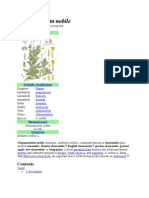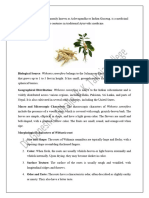0 ratings0% found this document useful (0 votes)
4 viewsInfografía Chamolile
Infografía Chamolile
Uploaded by
MarInfografia
Copyright:
© All Rights Reserved
Available Formats
Download as PDF, TXT or read online from Scribd
Infografía Chamolile
Infografía Chamolile
Uploaded by
Mar0 ratings0% found this document useful (0 votes)
4 views1 pageInfografia
Copyright
© © All Rights Reserved
Available Formats
PDF, TXT or read online from Scribd
Share this document
Did you find this document useful?
Is this content inappropriate?
Infografia
Copyright:
© All Rights Reserved
Available Formats
Download as PDF, TXT or read online from Scribd
Download as pdf or txt
0 ratings0% found this document useful (0 votes)
4 views1 pageInfografía Chamolile
Infografía Chamolile
Uploaded by
MarInfografia
Copyright:
© All Rights Reserved
Available Formats
Download as PDF, TXT or read online from Scribd
Download as pdf or txt
You are on page 1of 1
CHAMOLILE
1 Chamomile Introduction
Chamomile is an important medicinal herb originating from southern
and eastern Europe. Its cultivation has spread to regions like India,
where it has been grown for centuries. Chamomile has a long history
of medicinal use dating back to ancient civilizationssuch as Egypt,
Greece, and Rome. It is used for various ailments such as flatulence,
colic, hysteria, and intermittent fever.
2 Pharmacological and
Pharmaceutical Properties
Chamomile possesses a variety of pharmacological properties,
including anti-inflammatory, antiseptic, healing, and sedative
effects. The plant has been studied for its effects on liver function,
itstoxicity against certain larvae, and its bactericidal activity against
specific pathogens. Chamomile oil, extracted from the flowers, has
a high international demand and is used not onlyin pharmaceutical
products
3 BOTANICAL DESCRIPTION AND
TAXONOMY
It is an annual plant with specific characteristics such as
thin spindle-shaped roots, branched stems, and
distinctive flower heads. The generally accepted
botanical name for true chamomile is Matricaria recutita,
belonging to the genus Chamomilla and the family
Asteraceae.
4 COMMON NAMES AND
WIDESPREAD USE
Chamomile is known by a variety of
namesin different cultures. Its various
names include German chamomile,
Hungarian chamomile, Roman chamomile,
and English chamomile.
You might also like
- A Comprehensive Study of Therapeutic Applications of Chamomile - PMCDocument22 pagesA Comprehensive Study of Therapeutic Applications of Chamomile - PMCAngga HerfianNo ratings yet
- Chamomile Matricaria Is A: Matricaria Species Are Used As Food Plants by TheDocument1 pageChamomile Matricaria Is A: Matricaria Species Are Used As Food Plants by TheAlbanBakaNo ratings yet
- Chamaemelum NobileDocument3 pagesChamaemelum NobileNgeke KekeNo ratings yet
- ThymeDocument6 pagesThymeAnonymous 4PTbXjPuZNo ratings yet
- Manzanilla (Matricaria Chamomilla L)Document27 pagesManzanilla (Matricaria Chamomilla L)HURTADO COLLANTE ANGELICA MAXIMILIANANo ratings yet
- Assessment and DecisionDocument27 pagesAssessment and DecisionSayed SohailNo ratings yet
- Riview Myrtus PDFDocument8 pagesRiview Myrtus PDFPu DdingNo ratings yet
- Herbal PlantsDocument10 pagesHerbal Plantsjoe.kanichai08No ratings yet
- Rosemary Grass A Fragrant Herb With Endless PossibilitiesDocument8 pagesRosemary Grass A Fragrant Herb With Endless PossibilitiesEditor IJTSRDNo ratings yet
- Meliaceae Fami, Ly by Naveen C A JoishiDocument8 pagesMeliaceae Fami, Ly by Naveen C A JoishiNAVEEN C. A. JOSHI Officials,No ratings yet
- Fenugreek: Castor Oil PlantDocument6 pagesFenugreek: Castor Oil PlantNaseer AhmedNo ratings yet
- Final Chapter 6Document34 pagesFinal Chapter 6Tayyab Tahir MinhasNo ratings yet
- MyrrhDocument31 pagesMyrrhMekiya DefarNo ratings yet
- ImageDocument15 pagesImageRohit PrajapatNo ratings yet
- Drugs Obtain From FlowersDocument12 pagesDrugs Obtain From FlowersSunny PrinceNo ratings yet
- Artemisia Vulgaris Fact SheetDocument4 pagesArtemisia Vulgaris Fact SheetDaniela RusuNo ratings yet
- Different Extraction Methods and Antioxidant Properties of Thyme (Thymus Vulgaris L.) HerbDocument7 pagesDifferent Extraction Methods and Antioxidant Properties of Thyme (Thymus Vulgaris L.) HerbDIey ChokiEyNo ratings yet
- CloveDocument7 pagesCloveahmeda zayedNo ratings yet
- ABSTRACTDocument14 pagesABSTRACTbschem20211070No ratings yet
- Chamomile (Matricaria Recutita, Anthemis Nobilis) : Paula GardinerDocument21 pagesChamomile (Matricaria Recutita, Anthemis Nobilis) : Paula GardinerDina100% (1)
- Acorus Calamus - WikipediaDocument38 pagesAcorus Calamus - WikipediaLiza RellamaNo ratings yet
- Review Article On Medicinal Plant AloeDocument14 pagesReview Article On Medicinal Plant AloeIJPS : A Pharmaceutical JournalNo ratings yet
- Dioscorea Species An Important Under-Exploited Medicinal Plant and A Potential Root Crop For AgroforestryDocument5 pagesDioscorea Species An Important Under-Exploited Medicinal Plant and A Potential Root Crop For AgroforestryAkshayNo ratings yet
- Botany Lec.1Document9 pagesBotany Lec.1ُEl SyrianoNo ratings yet
- COMPOSITAEDocument36 pagesCOMPOSITAEAmmara AmyNo ratings yet
- Medicinal PlantsDocument64 pagesMedicinal Plantsphd0780No ratings yet
- Literature Review On Curcuma CaesiaDocument4 pagesLiterature Review On Curcuma CaesiaPratik KanchanNo ratings yet
- 10 Economically Beneficial PlantsDocument17 pages10 Economically Beneficial PlantsShruti SivadasanNo ratings yet
- Plantes Medicinals EgipteDocument66 pagesPlantes Medicinals EgipteAbdullah AnsarNo ratings yet
- Commiphora Myrrh A Phytochemical and Pharmacologic PDFDocument17 pagesCommiphora Myrrh A Phytochemical and Pharmacologic PDFWaterfall ShapelessNo ratings yet
- MANZANILLADocument2 pagesMANZANILLAkarenescobar.090No ratings yet
- Ijnpr 6 (4) 261-267Document7 pagesIjnpr 6 (4) 261-267pamely peseNo ratings yet
- Agrimony Agrimonia Eupatoria KeelDocument12 pagesAgrimony Agrimonia Eupatoria KeelAlejandra Guerrero100% (2)
- Medicinal Plants For Skin Diseases Remedies: Aimen Tariq 2017-Ag-0329Document16 pagesMedicinal Plants For Skin Diseases Remedies: Aimen Tariq 2017-Ag-0329Moiez AhmadNo ratings yet
- Aloe VeraDocument14 pagesAloe Vera80,795,086 likesNo ratings yet
- Lemon Grass-Shruti RanadeDocument6 pagesLemon Grass-Shruti RanadeMarites ParaguaNo ratings yet
- MSC Sem II P IV Medicinal Botany - NEPDocument13 pagesMSC Sem II P IV Medicinal Botany - NEPvs800310No ratings yet
- Hansraj College: Powerpoint PresentationDocument57 pagesHansraj College: Powerpoint PresentationRajsi RajputNo ratings yet
- AlbiziaDocument4 pagesAlbiziaChen222No ratings yet
- Actividad Antimicrobiana de Cuminum Cyminum LDocument13 pagesActividad Antimicrobiana de Cuminum Cyminum LJuan Yana MangoNo ratings yet
- Role of Herbs in Cosmetology & Its ImportanceDocument6 pagesRole of Herbs in Cosmetology & Its Importanceapi-164781734No ratings yet
- Pudina MintDocument10 pagesPudina MintjunaidNo ratings yet
- I J NPR Research Paper PublishedDocument8 pagesI J NPR Research Paper PublishedVALERIA RODRIGUEZ CASPITONo ratings yet
- Origanum Majorana L. - Phyto-Pharmacological Review: January 2015Document8 pagesOriganum Majorana L. - Phyto-Pharmacological Review: January 2015VALERIA RODRIGUEZ CASPITONo ratings yet
- Abstract: Ipomea Hederacea Jacq. (Kaladana or Ivy Leaf Morning-Glory), A Member of TheDocument10 pagesAbstract: Ipomea Hederacea Jacq. (Kaladana or Ivy Leaf Morning-Glory), A Member of TheNayan jainNo ratings yet
- Yarrow: ERB Erbert Favourite HerbsDocument1 pageYarrow: ERB Erbert Favourite Herbsios007No ratings yet
- Yarrow: ERB Erbert Favourite HerbsDocument1 pageYarrow: ERB Erbert Favourite HerbsSasho SpasovskiNo ratings yet
- Rgab 008Document15 pagesRgab 008Amine ServicesNo ratings yet
- Balm of Gilead-Insect RepellentDocument1 pageBalm of Gilead-Insect RepellentSasho SpasovskiNo ratings yet
- Turmeric Wikipedia 1667813480011Document5 pagesTurmeric Wikipedia 1667813480011Marlvin PrimeNo ratings yet
- Fragrance CompositionDocument5 pagesFragrance CompositionValentino DhiyuNo ratings yet
- Inroduction: Language NameDocument7 pagesInroduction: Language Name80,795,086 likesNo ratings yet
- Cosmetics: Rosmarinus o Plant With Uses in Personal Healthcare and CosmeticsDocument17 pagesCosmetics: Rosmarinus o Plant With Uses in Personal Healthcare and CosmeticsDavid RuizNo ratings yet
- Chemical Eng. NeemDocument11 pagesChemical Eng. NeemCALEB ALHASSANNo ratings yet
- ChamomileDocument2 pagesChamomileSofi ChmielewskaNo ratings yet
- Chamomile GermanDocument1 pageChamomile Germanios007No ratings yet
- Medicinal Study of Zingiberaceae PlantsDocument65 pagesMedicinal Study of Zingiberaceae PlantsPravin NagoreNo ratings yet
- Thyme & Oregano, Healing and Cooking Herbs, And more than 30 Ways To Use ThemFrom EverandThyme & Oregano, Healing and Cooking Herbs, And more than 30 Ways To Use ThemNo ratings yet
- Health Benefits of Rosemary For Cooking and HealthFrom EverandHealth Benefits of Rosemary For Cooking and HealthRating: 5 out of 5 stars5/5 (1)



























































